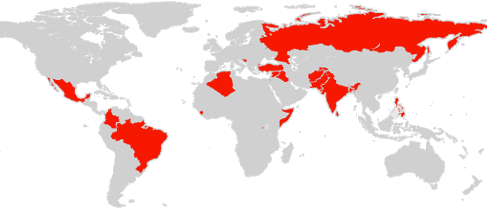Violence and threats against journalists, particularly in provincial areas, remained widespread as President Benigno Aquino’s vow to end impunity in media murders went unfulfilled during his third year in office. At least three journalists were killed in 2013, one of whom was radio reporter Fernando “Nanding” Solijon. A police officer was later identified as a suspect and placed under house arrest. At least six other reporters were killed in 2013. CPJ is investigating their killings to determine whether they were related to the journalists’ work. Authorities took a small step toward combating impunity by convicting the gunman in the 2011 murder of journalist Gerardo Ortega, but the process was undermined by the release of the case’s two suspected masterminds, including the ex-governor of Palawan province. The Maguindanao massacre trial for the 2009 killings of 32 journalists and media workers failed to convict any of 197 suspects after nearly four years of legal proceedings. Reforms to the criminal justice system, including new mechanisms to expedite priority cases, failed to break the trial’s procedural deadlock. At least four journalists were killed and six went missing in the huge typhoon that hit the Philippines in November.
Philippines
» Slow progress in Maguindanao massacre case underscores culture of impunity.
» Three journalists are killed in relation to their work; six others slain with uncertain motives.
Violence and threats against journalists, particularly in provincial areas, remained widespread as President Benigno Aquino’s vow to end impunity in media murders went unfulfilled during his third year in office. At least three journalists were killed in 2013, one of whom was radio reporter Fernando “Nanding” Solijon. A police officer was later identified as a suspect and placed under house arrest. At least six other reporters were killed in 2013. CPJ is investigating their killings to determine whether they were related to the journalists’ work. Authorities took a small step toward combating impunity by convicting the gunman in the 2011 murder of journalist Gerardo Ortega, but the process was undermined by the release of the case’s two suspected masterminds, including the ex-governor of Palawan province. The Maguindanao massacre trial for the 2009 killings of 32 journalists and media workers failed to convict any of 197 suspects after nearly four years of legal proceedings. Reforms to the criminal justice system, including new mechanisms to expedite priority cases, failed to break the trial’s procedural deadlock. At least four journalists were killed and six went missing in the huge typhoon that hit the Philippines in November.
At least three journalists were killed in the Philippines 2013 in direct relation to their work, according to CPJ research.
At least 76 journalists have been killed for their work in the Philippines since 1992, when CPJ began keeping detailed records of journalist fatalities. Philippines is ranked the second deadliest country in the world for journalists, according to CPJ research. Most of the journalists killed covered politics or corruption.

| 1. Iraq: 161 2. Philippines: 76 3. Syria: 61 4. Algeria: 60 5. Russia: 56 6. Pakistan: 53 7. Somalia: 52 | 8. Colombia: 45 9. India: 32 10. Mexico: 29 11. Brazil: 27 12. Afghanistan: 24 13. Turkey: 21 14. Sri Lanka: 19 | 15. Bosnia: 19 16. Rwanda: 17 17. Tajikistan: 17 18. Sierra Leone: 16 19. Bangladesh: 14 20. Israel and the Occupied Palestinian Territory: 12 |
For the fourth consecutive year, the Philippines ranked third worst on CPJ's Impunity Index, which calculates unsolved journalist murders as a percentage of each country's population. The lack of convictions in the Maguindanao massacre case has entrenched the country's position on the index.

| 1. Iraq 2. Somalia 3. Philippines | 4. Sri Lanka 5. Colombia 6. Afghanistan | 7. Mexico 8. Pakistan 9. Russia | 10. Brazil 11. Nigeria 12. India |
The Internet penetration rate in the Philippines increased with the growing accessibility of smartphones and other hand-held communication devices. The Cybercrime Prevention Act of 2012, which the president signed into law in September, broadly threatened online freedoms but was not enforced pending a temporary restraining order by the Supreme Court.
